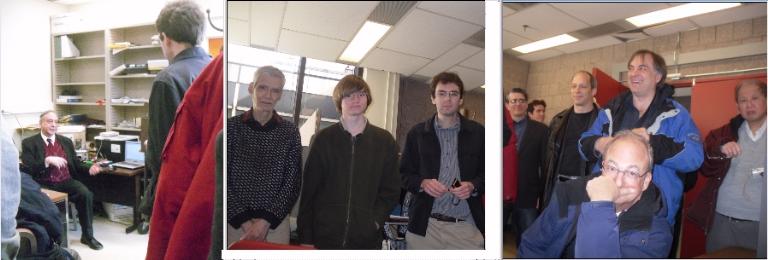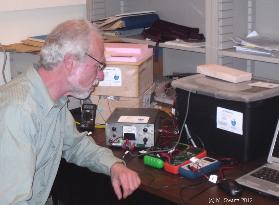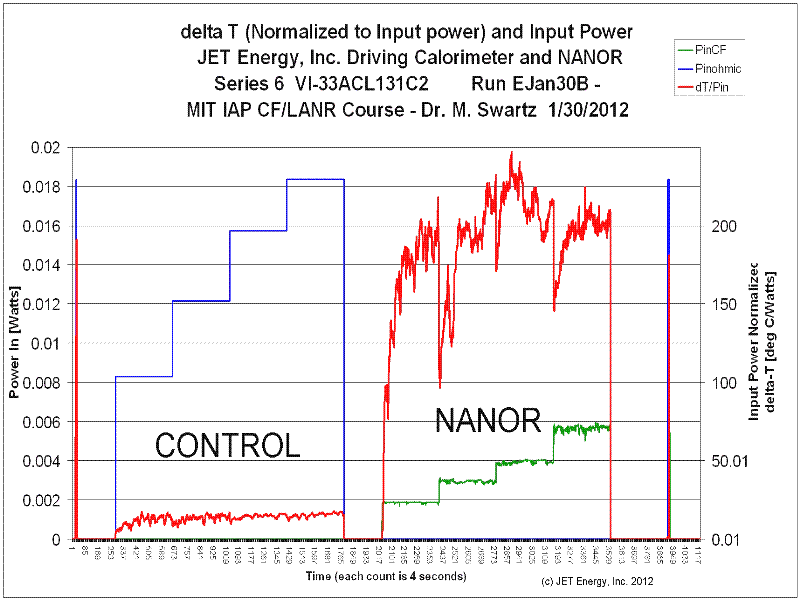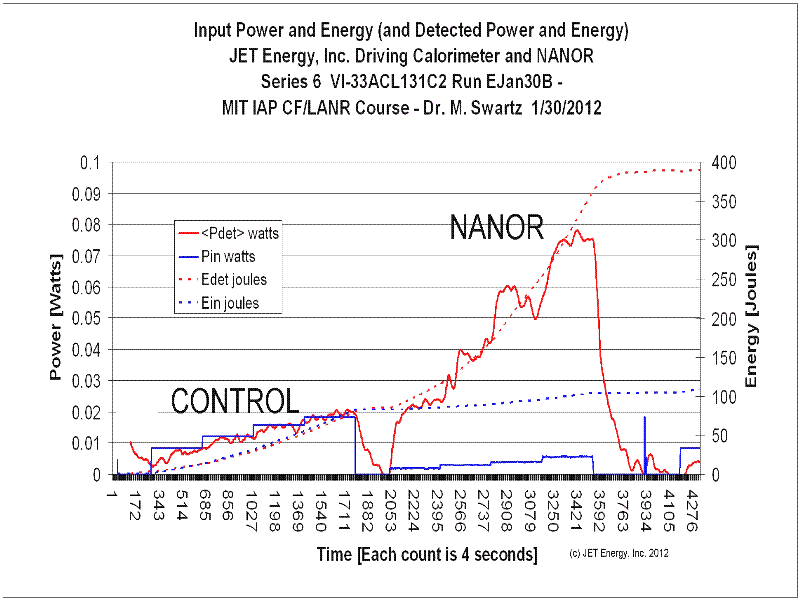JET Energy,
Inc.
JET Energy | JET Tech | NANOR Tech | PHUSOR Tech | JET Refs | CHERRY Tech | Contact
JET Energy
NANOR®-type
LANR Technology

NANOR®-type Clean Energy Technology depends upon lattice assisted nuclear reactions (LANR) which use hydrogen-loaded alloys to create heat. They offer new hope for energy production. JET Energy has just introduced this new generation of LANR preloaded nanocomposite ZrO2-PdNiD CF/LANR quantum electronic devices which are active, and capable of energy gain. These feature two (or more) terminals and self-contained superior handling properties enabling portability and transportability. NANOR-type lattice assisted nuclear reaction [LANR] devices use hydrogen alloys to create heat and other reactions. Most importantly, the activation of the desired cold fusion reactions is, for the first time, separated from the loading. This system has already been demonstrated using the more reproducible nanostructured CF/LANR quantum electronic devices at MIT in 2012.
NANOR® -type generated Clean Energy Technology creates an energy gain of up to 16 times more than is put in. The Carbon Footprint is zero.
In the case of these new NANORs, the activation is for the first time, separated from its loading. This is a high efficiency heat producing system. Furthermore, the proprietary microprocessor controlled system has also led to an evolving series of improved driving paradigms to qualitatively explore and then exploit loaded nanostructured, nanocomposite, and other materials including semiquantitatively examining them for usefulness, heat-production activity, linearity, time-invariance, and even the impact of additives and contaminants.
2012 OPEN DEMONSTRATION
of NANOR® -Type LANR
At MIT 
JET Energy NANOR-type Clean Energy Technology was demonstrated at MIT in 2012.
The 2012 Open LANR/CF Demonstration at MIT had parallel diagnostics including calorimetry, input-power-normalized delta-T, and focused heat flow measurement, and several calibrations. One of the calibrations included an ohmic (thermal) control located next to the NANOR, used to ascertain activity. To enable demonstrations at MIT for the NANOR system, including in the MIT IAP class where multiple experiments had to be shown to classes, or otherwise run over times of two hours, a specialized heat flow semiquantitative analyzer was specially developed. The heat which this preloaded NANOR-type LANR device demonstrated was monitored three ways by three (3) independent systems for semiquantitative measurement of the energy produced. Furthermore, the output of the NANOR is compared to an ohmic control.
First, the energy produced is instantaneously and kinematically determined by the ratio of the input power normalized temperature increase, called by the symbol 'delta T/Pin' referring to the increase of temperature (delta T), divided by the input electrical power (Pin). Second, it is also instantaneously and kinematically evaluated over a wide area by the ratio of the input power normalized heat flow leaving it, called by the symbol 'HF/Pin' referring to the heat flow (HF) divided by the input electrical power (Pin). Third, it is examined by calorimetry, calibrated by the thermal ohmic control, and confirmed by long-term time integration. These three methods of verification are pooled to derive very useful information, semiquantitatively ascertain energy produced, and infer activity.
The preloaded NANOR-type LANR device demonstrated energy gain which ranged generally from 5 to 16. It was 14.1 energy gain while the MIT IAP course was ongoing. During Feb. and March, through a range of experiments, the NANOR™ continued to produce excess energy, confirmed by daily calibrations.


For the entire months of February through April 2012, the NANOR® continued to produce excess energy, with daily calibrations against an ohmic thermal control; thus, it also confirmed the existence of CF/LANR daily during that time. By comparison, and also worth noting, the historic 2003 open demonstration of CF/LANR at MIT needed two full tables for the setup, whereas the 2012 NANOR demonstration at MIT needed only a single standard sized desk top.
This open demonstration confirmed the existence, reproducibility, and improved control of CF/LANR reactions, and as importantly, has shown a superior preloaded nanostructured LANR material and driving device. Some have said that this open demonstration of LANR by a NANOR-type device may have been the longest openly demonstrated fusion reaction on Earth in history.

Fig. 1 - Input Power and Resulting Output Temperature rise [normalized to input electrical power] of a self-contained CF/LANR quantum electronic component Series 6-33ACL131C2; EJan30B, a two terminal NANOR™-type device containing active preloaded ZrO2-PdD nanostructured material at its core.
Figure 1 is set of curves which plot the temperature rise [delta-T in degrees C] of the preloaded NANOR-type LANR device and the ohmic control normalized to four levels of input electrical power. Each is shown with as a thermal output response to its electrical input. The several regions present the differential temperature rise normalized to input electrical power for the preloaded NANOR, for the case with no input power ("Background"), and for the case of input to the ohmic thermal control, located at the core. The x-axis represents time, and each count represents four (4) seconds. The y-axis on the left side represents electrical input power in watts. Each of the outputs are read off of the right hand side. The y-axis on the right side represents the amount of temperature rise (differential temperature increase) normalized (that is, divided by) to the electrical input power. The units of this axis are in degrees Centigrade/Watt. Calibration pulses, used for accuracy and precisions checks of voltages and currents, are also shown.
Fig. 1 heralds the excess energy achieved by the NANOR type of LANR device. Compare the delta-T output normalized to input power for preloaded NANOR-type LANR device to the thermal (ohmic) control. It can be seen that the input power normalized delta-measurements suggests strongly the presence of excess heat. Observe that despite lower input electrical power to the NANOR, the temperature rise normalized to input electrical power observed in the core was higher than expected, as compared to the ohmic control. Attention is directed to the fact that the active preloaded LANR quantum electronic device again clearly shows significant improvement in thermal output, here input-power-normalized compared to a standard ohmic control (a carbon composition resistor).

Fig. 2 - Input and Heat Output of a two terminal NANOR™-type device Series 6-33ACL131C2 device, showing the calorimetric response at several input powers, for the device and the ohmic control.
Figure 2 shows curves which plot the electrical input power, at several input power levels, and the calorimetric responses of both the preloaded NANOR-type device and the ohmic control. The x-axis represents time, and each count represents four (4) seconds. The y-axis on the left side represents electrical input power in watts. The y-axis on the right side represents the amount of energy released. The units of this axis are in joules. The figure shows the input, and the calorimetry, of preloaded NANOR along with that for the ohmic thermal control used to calibrate the system. Those calibration pulses, used for accuracy and precisions checks of voltages and currents and time, are also shown. The inputs to the thermal ohmic control, followed by the preloaded NANOR-type device, are shown, as are the calibrated calorimetric outputs for both. Each of the outputs are read off of the right hand side. The latter curves represent time integration to determine total energy. They thus rule out energy storage, chemical sources of the induced heat, and other sources of possible false positives. Compare the output for NANOR-type LANR device to the thermal (ohmic) control. As can be seen, this semiquantitative calorimetry, itself calibrated by thermal waveform reconstruction, was consistent with excess heat being produced only during energy transfer to the NANOR-type LANR device. Notice that the active preloaded LANR quantum electronic device clearly shows significant improvement in thermal output compared to a standard ohmic control (a carbon composition resistor). The graph, taken from the MIT IAP January 2012 class, is representative of the NANOR-type of CF/LANR technology, and its shows quite clearly demonstrated over unity thermal output power from the NANOR, at a level close to 78 milliwatts.
This open demonstration over months has demonstrated that microprocessor controlled integrated circuits using LANR quantum optical devices containing preloaded nanostructured LANR material can be used as an effective very clean, highly efficient, energy production system, apparatus, and process. Tomorrow, preloaded LANR nanostructured materials and devices will also be useful for integrated circuits and other applications using a pre-activated nanostructured and other materials. These include high power, high-efficiency, self-contained, autocontrolled, preloaded, energy production devices and systems enabling their remote activation for electronic, bioelectronics, space and avionic circuits, IC devices, and AI systems.
PHUSOR® and NANOR® are registered trademarks. NANOR® -type LANR technology, and PHUSOR®-type LANRtechnology, and other discussed IP herein is protected by U.S. Patents D596724, D413659 and other Patents pending.
JET Energy, Inc. |
"Working on the Most Efficient and Cleanest Heat Products Available" |